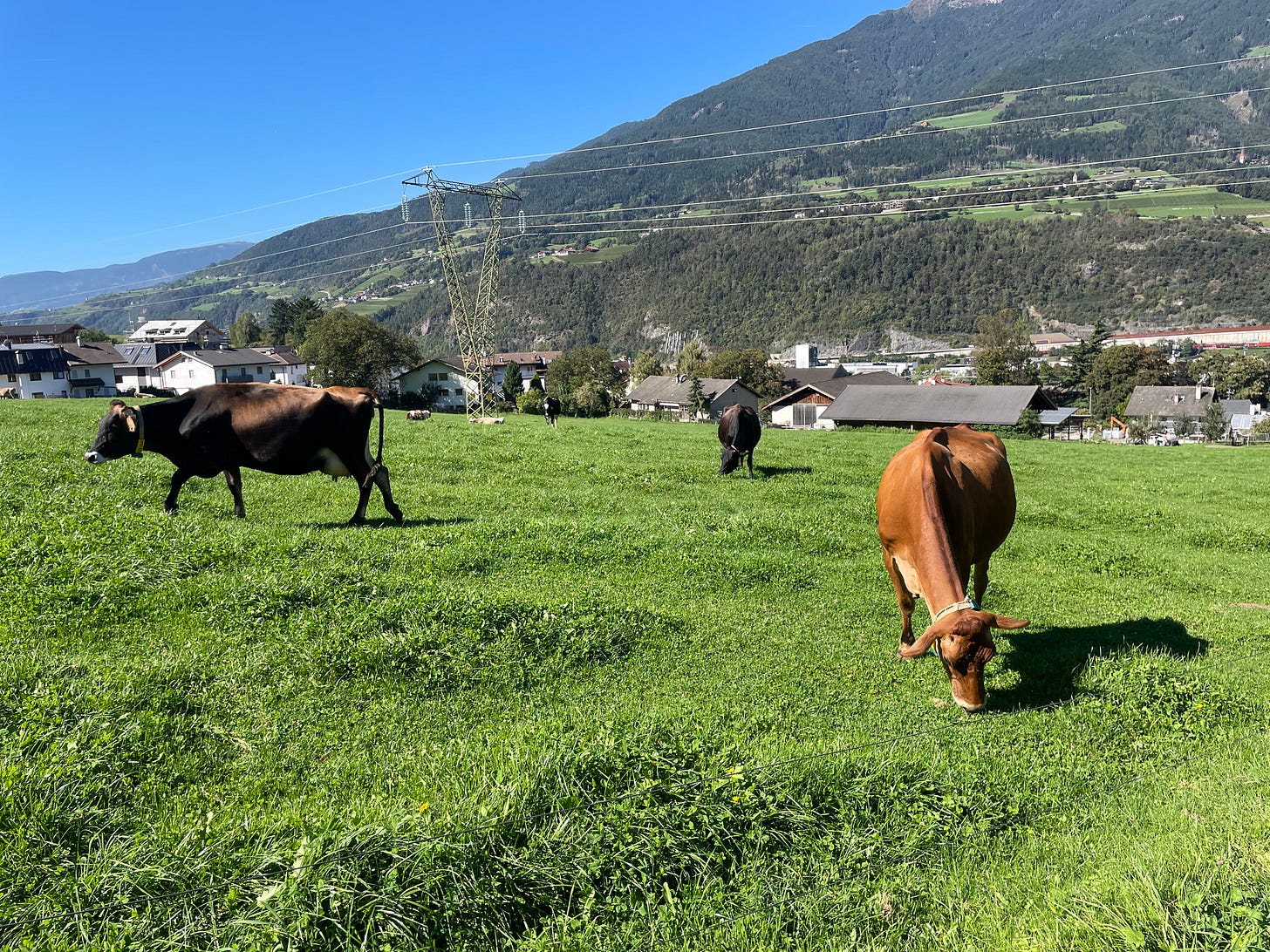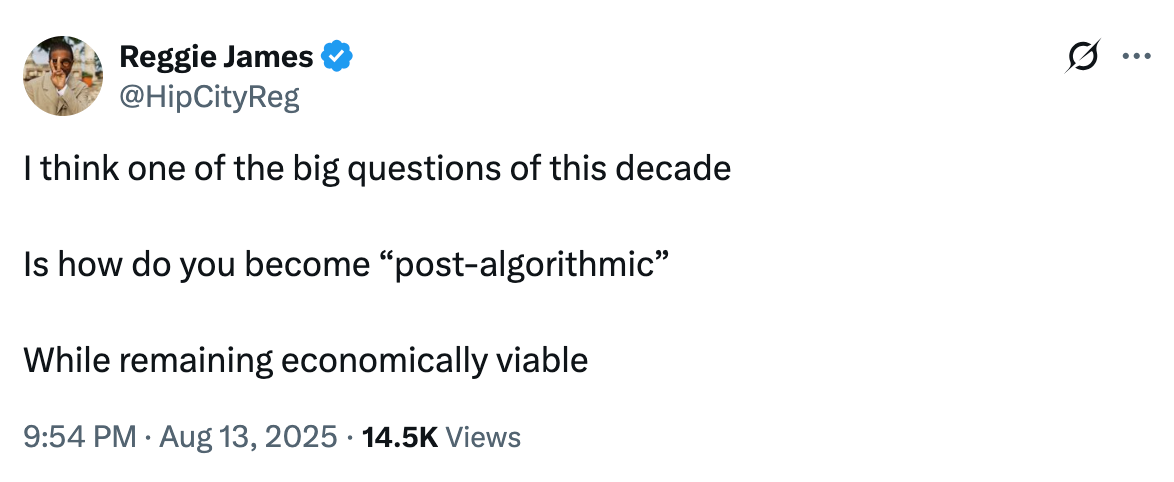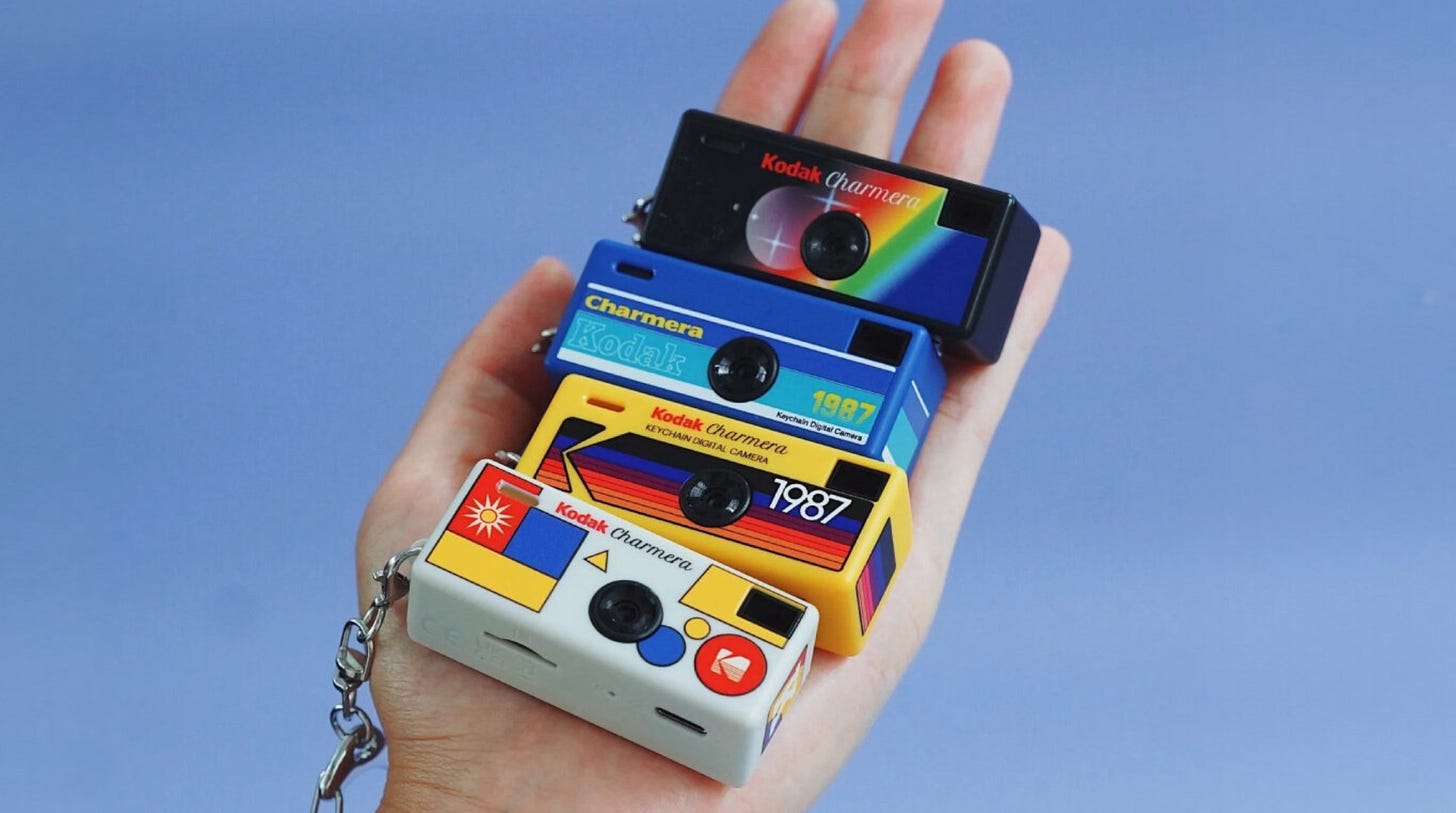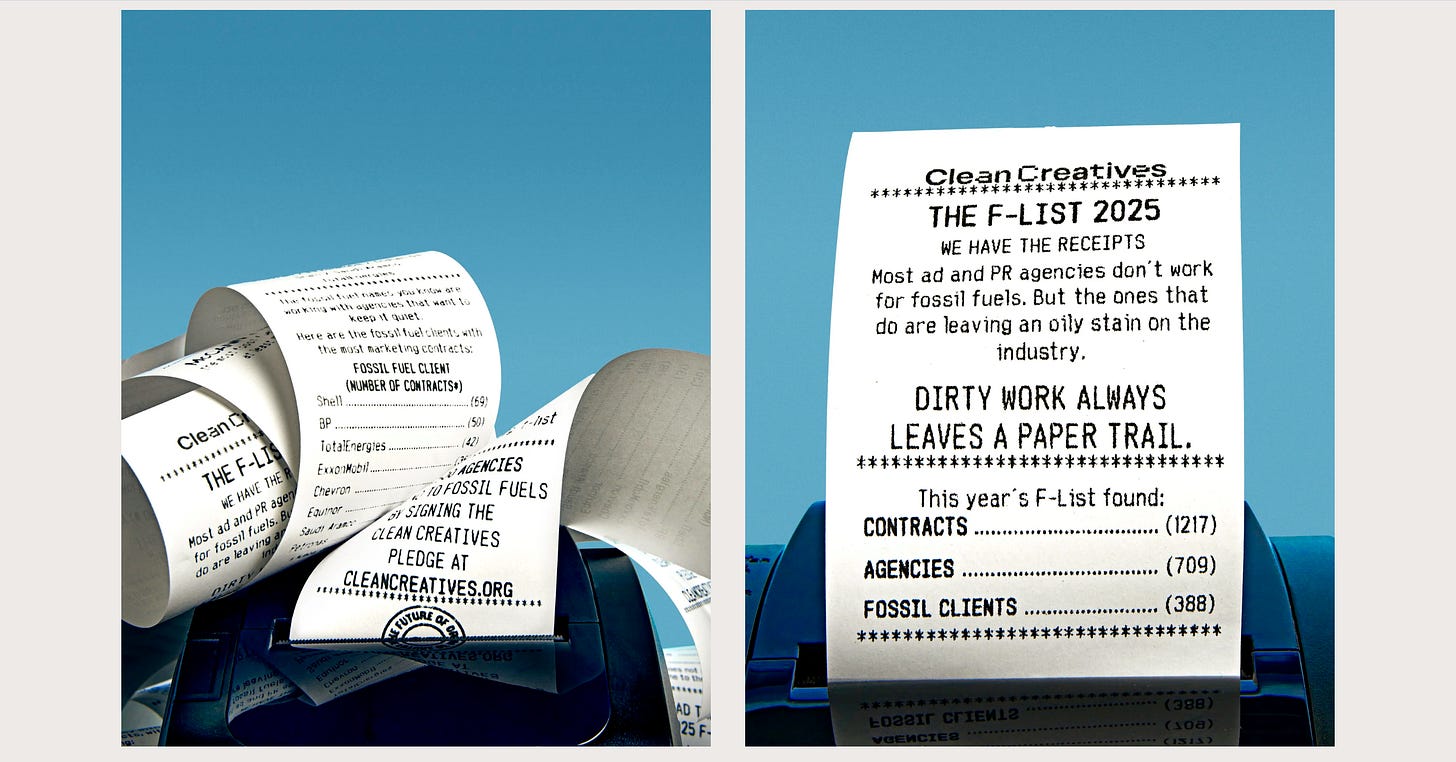Rabbit Holes 🕳️ #170
From doomprompting to mass psychosis, half presence, back to chatgpt, complexity thinking, gently undermining power, borrowing a drill, positive tipping points and wind turbine homes
Hello!
I’m finally back with another Rabbit Holes issue. What kept me busy these last few weeks? A move from Berlin to South Tyrol, Italy. Quite a change of scenery…😅 and a lot to get sorted and adjust to. Check out my new neighbors:
As I am now getting a bit more settled, day by day, I can again spend some time on this newsletter, nurturing you with the usual, thought-provoking framings and reframings.
Aaaand – as you can probably see – the newsletter finally got a little design upgrade, all thanks to Kshitija Gurav. 😁
Alright, enough chitchat and onto this week’s Rabbit Holes:
THIS WEEK ↓
🖼️ Framings: Doomprompting // Mass Psychosis // Half Presence
📊 Numbers: Back to School ChatGPT
🌀 Re-Framings: Systems Thinking → Complexity Thinking // Confronting Power → Gently Undermining Power // Borrowing A Drill
🧬 Frameworks: Positive Tipping Points Toolkit
🎨 Works: Wind Turbine Homes // Kodak Keychain // Clean Creatives' F List
⏳ Reading Time: 10 minutes🖼️ Framings
Naming Framing it! Giving something we all feel more prominence in a way that promotes a deeper reflection.
💬 Doomprompting
Another great framing by the always insightful Anu. I’m increasingly interested in how limitations can lead to a more fulfilling life (and “world”), so I really like how Anu talks about the bottomless page being the root cause of the “modern creator” overwhelm as opposed to the blank page, which of course is the main pitch of these AI tools. We don’t need less friction, but more – because friction equals Life.
“The blank box of ChatGPT, Claude, or your large language model of choice staring back at you felt like a clean slate. Here was a remarkable new technology that put the world’s knowledge at our fingertips, and all it asked of us was intention.
But even the most promising technologies have an evil twin, and the blank box of curiosity is no exception. Where social media trained us to passively consume, the dark side of AI trains us to passively “converse” and “create.”
The actions feel similar but the result emptier. We cycle through versions meant to arrive closer but end up more lost. Our prompts start thoughtful but grow shorter; the replies grow longer and more seductive. Before long, you're not thinking deeply, if at all, but rather half-attentively negotiating with a machine that never runs out of suggestions. Have you considered...? Would you like me to…? Shall I go ahead and…? This slot machine’s lever is just a simple question: Continue?
The modern creator isn't overwhelmed by a blank page; they're overwhelmed by a bottomless one. AI gives you ever more options, then appoints itself your guide. It tells you it’ll save time, then proceeds to steal it while you’re happily distracted.
Doomprompting is the new doomscrolling. […]
I started thinking about this behavioral pattern last year, but it’s become increasingly clear that we've entered the age of synthetic social media, where you're always conversing with an other but with no human stakes. […]
The shift from consumption to participation makes the illusion far more convincing, and the addiction far more sophisticated. […] The dopamine of likes and follows is now the dopamine of felt productivity, social validation, and intellectual partnership.”
» Doomprompting Is the New Doomscrolling. by Anu
😵 Mass Psychosis
Being very busy in (and with) the offline world in recent weeks has led to me being even more estranged from social media. The more you’re off it, the less you miss it. Social media is shifting from a weapon of mass distraction to a weapon of mass psychosis.
“Since deleting my Twitter account nearly three years ago, I’ve generally ignored social media. However, in the last 48 hours I’ve spent enough time studying the response to Kirk’s death to be further convinced that platforms like X and TikTok are destroying our culture. No metaphor does the problem justice. I’ve compared social media to a dangerous psychological experiment, a hallucination machine, a funhouse mirror, a digital sewer—but nothing captures the ludicrous insults, moral injuries, and delusions that millions of us avidly produce and consume online. If the medium is the message, the message is mass psychosis—and it will send us careening from one political emergency to the next. The fact that some of the most deranging and divisive content is being created (or amplified) by foreign adversaries—and that we have literally built and monetized their capacity to do this—beggars belief. We are poisoning ourselves and inviting others to poison us.
More disturbing still, the effects are self-reinforcing. […]
Social media amplifies extreme views as though they were representative of most Americans, and many of us are losing our sense of what other people are really like. Many seem completely unaware that their hold on reality is being steadily undermined by what they are seeing online, and that the business models of these platforms, as well as the livelihoods of countless “influencers,” depend on our continuing to gaze, and howl, into the digital abyss.
Get off social media. Read good books and real journalism. Find your friends. And enjoy your life.”
» We Are Losing the Information War with Ourselves by Sam Harris
👀 Half Presence
P.E. Moskowitz is talking aobut the crisis of presence or said differently: the growing half-presence that we all exhibit these days. Really like how P.E. notes that at the core of this is a fear of full presence as he writes: “If you left your house without a phone, I think it is not just that you would miss the phone, it is that you would be scared about what comes up without it.”
“I have been thinking a lot about presence recently. Often, we are there—hanging with a friend, or watching a movie, or by ourselves, wherever—but we are not really there. Because we are also somewhere else. To be fully present is to be a full self. To fully exist. To fully interact with something or someone. To take up space and contribute back to it. Presence exists on a spectrum. Perhaps 100 percent presence is and always has been rare, but there are gradations, and it feels like often these days, I, and many of us, do not get anywhere near full-presence.
More often than not, my mind feels pulled in a million different directions. If I am chatting with a friend, I am often thinking about something else (the world and how insane it is, namely). If I am watching a movie, I feel almost physical discomfort if I leave my phone in the other room. If I am working, I am also texting friends. Full presence is a challenge.
It is easy to blame everything around us for our lack of presence—politics making us too anxious to fully be there for each other, work wearing down our ability to concentrate on good things because we’ve used up all that concentration on mundane tasks, phones addicting us to being never fully present.
But I’ve also come to realize I am also culpable for my lack of full presence. I do it to myself—turning the volume knob of my own fullness, my own concentration, my own ability to contribute to any given situation down from an 8 or 9 to a 5 or 4. Because full presence not only feels hard, it feels painful. And I think that’s because the more present one is, the more present the world is within you. The more your eyes are open, the more they can ingest. And with the world in its current state, perhaps we all want to keep our eyes half-closed."
In this way, I think our common claim of internet overwhelm—that we all take in too much information now due to social media—is wrong, or right in the wrong way. Yes, we all see and process much more information than we once did, but the total effect of our interaction with the internet is to make us see and feel less: to be half on your phone and half in the real-world is to take in nothing fully from either, to not fully understand or contribute to either. Thus it is, in a way, actually a form of information scarcity.”
» Full Presence Is Terrifying by P.E. Moskowitz
📈 Numbers
A thought-provoking chart that perfectly captures a pivotal shift:
🎒 Back to School ChatGPT
🌀 Re-Framings
A few short re-framings for building better systems or worlds that I’ve recently come across:
🧬 Systems Thinking → Complexity Thinking
“Systems thinking was a breakthrough when it first emerged. It gave us a way to zoom out, recognize patterns, and understand how different parts of a system affect one another. […] But systems thinking can be misleading. It can tempt us into believing that if we just map carefully enough, we’ll understand the whole […]. Systems thinking assumes boundaries are clear, flows are predictable, and feedback loops can be managed. That neatness is comforting, but also false. The real world doesn’t sit politely inside our diagrams. It spills over, adapts, and surprises us.
This is where complexity thinking takes over, in the right environment. Complexity thinking doesn’t flatter us with illusions of control. It demands that we live with uncertainty, non-linearity, and emergence. Outcomes don’t always match inputs. What worked yesterday might backfire tomorrow. In a complex system, the whole isn’t just greater than the sum of its parts, it can become something entirely different, shaped by interactions no map or org chart can capture.
So the shift isn’t about discarding systems thinking, it’s about refusing to stop there. […] Some decisions can and should be made in the complicated world, where cause and effect are knowable. But many critical choices today live in the complex world, where emergence rules and adaptive leadership is required.”
» Systems Thinking Isn’t Enough Anymore by Super Cool & Hyper Critical
🤜🤛 Confronting Power → Gently Undermining Power
“There are two big climate marches this weekend. Reading their respective press releases, it struck me that there’s an interesting contrast between them that’s worth reflecting on. […]
First, Draw the Line. This is a global protest with events taking place all weekend. […] There will be a combination of marches, strikes, walkouts and art interventions, all aiming to “draw the line against injustice, pollution, and violence – and for a future built on peace, clean energy, and fairness.” The idea is to do this now, ahead of COP30, as a way of insisting that these climate talks be the turning point.
There’s a big coalition behind all this, including climate justice organisations, indigenous people movements, new economics campaigns and human rights groups. Perhaps as a result of this broad coalition, the list of demands sprawls a bit. […] By the end of the list, we’ve drawn lines relating to changing ‘the system’, stopping fossil fuels, cancelling debt, divestment, taxing billionaires, fair trade, land rights and the Gaza genocide. “Redistribute wealth and power,” demands point six in closing. “End colonialism, patriarchy, and racism.”
It’s hard to argue with any of these, but it’s a lot to be getting on with. If you saw the march go by in the street, would you know what they were calling for? […]
Onto the second big campaign of the weekend then: Sun Day. With its cheeky riff on Earth Day, Sun Day invites people to “rise up for a sun-powered planet” with a day celebrating the power of clean energy. There will be e-bike parades, solar installations and the official opening of new solar parks, and tours of heat pumps and other clean tech in local neighbourhoods. It’s a pretty free and easy brief, with film screenings and open homes, and walking tours of solar installations. A town in Ohio is hosting Porchfest, where solar-powered music performances will be held on people’s front porches. […]
These are two very different approaches:
Draw the Line, despite outlining what they’re marching for, is predominantly negative in its framing. SunDay is overwhelmingly positive.
The first presents a wish-list to the powerful and hopes that they will act. The second celebrates climate actions that people are doing for themselves.
Justice issues are inextricably linked, and so Draw the Line has thrown its net wide and included every cause going. SunDay has one clear message and captures it in the name.
Draw the Line is fundamentally about scarcity: there isn’t enough to go around and some people have been left out. SunDay is about abundance: nobody owns the sun.
Draw the Line confronts power. SunDay gentles undermines it.
In comparing the two, I’m not trying to establish which one is best. The more interesting question is which one is the most timely. Which one captures the mood and speaks most effectively to this particular moment?”
» Marching for and marching against by Jeremy Williams
🔩 Borrowing A Drill
🧬 Frameworks
One small, handy framework to build more regenerative, beautiful, and just systems:
The Positive Tipping Points Toolkit by the Green Futures Network at the University of Exeter
🎨 Works
Some hand-picked, particularly thought-provoking and inspiring work:
That’s it for this week’s Rabbit Holes issue!
Did you enjoy this week’s issue? If so, tap the ❤️. It helps more people discover this and shows me what’s resonating.
Thanks for supporting my work! 😊














Great curation, Thomas! I enjoyed venturing down this rabbit hole in reflections on creating more presence in our lives.The doomprompting framing clicked for me with that bottomless page vs blank page distinction. Congrats on the move to South Tyrol!
Welcome back! we missed you! Also, where did you move? I am originally from the Trento province in Italy and that foto looks extremely familiar! (last time I visited I went up on a mountain to get berries and yogurt and there were cows and donkeys so I HAD TO make a video of me singing 'the hills are alive with the sound of donkeyssss'. 10 stars for the effort)